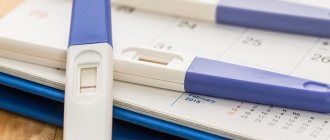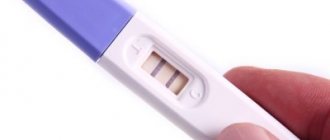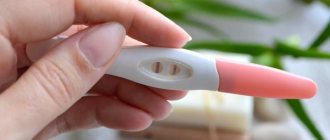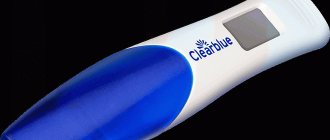There are several ways to find out about pregnancy. A woman can feel her situation by early subjective signs, take a blood test or do a simple test. The latter is the most common method of diagnosing pregnancy, which makes it possible to indicate with a high degree of probability that conception has occurred. But it happens that a woman is confident that she is pregnant, but the test says otherwise. But do not despair, because false negative results are very often observed.
What is a false negative test
A pregnancy test, in principle, can determine its onset even before the first signs appear.
The accuracy of this method is on average 98%. The remaining percentages account for cases of errors, often in the direction of absence of pregnancy. This result is called a false negative pregnancy test.
Briefly about the working mechanism
All pregnancy tests, regardless of the type, work on the same principle. Whether it’s an ordinary strip strip or a digital device, they react to one substance – the hCG hormone.
Human chorionic gonadotropin is produced in the body of a pregnant woman from the moment of conception and its level gradually increases. Thus, the hCG level in a woman who is not expecting a baby is practically zero, while in an expectant mother it increases several thousand times during pregnancy.
Modern pregnancy tests contain a special reagent that allows the diagnostic strip to turn red when there is an increased level of the hCG hormone in the urine.
The most sensitive “devices” react to a level of 10 mIU/ml, and ordinary ones – from 25 mIU/ml. Accordingly, if the hCG level exceeds these indicators, a second strip appears on the device. Reference! The level of hCG in urine detected by the tests is not produced until the third or fourth week of pregnancy. Therefore, it is useless to do a home test immediately after sexual intercourse - it will show a negative result.
Most common reasons
The accuracy of the result may depend on many factors, from poor quality diagnostic equipment to fetal pathology. Below is a list of possible reasons for a false negative result.
| Reason one | Conducting the test very early, or whether the test can lie before the delay. | This is the most common reason among mothers who have long dreamed of pregnancy and children. They strive to find out about their interesting situation as quickly as possible and are in a hurry to carry out an exciting test. It is important to understand that pregnancy is determined using this method based on the sensitivity of the tests to hCG (human chorionic gonadotropin). The growth of this hormone occurs from the beginning of pregnancy, but its content differs at different stages. After conception, the concentration of the hormone in the urine is so minimal that the device simply “does not see” it. The sensitivity is indicated on each test, which is worth keeping in mind when choosing among the many options. If you want to find out the result quickly, then you should spend money on a more expensive one, and if the result is negative, don’t be upset, but repeat the procedure two days later (ideally, you should choose a different test company). If a woman has regular menstruation, then she can, if not exactly, then approximately, tell the expected date of the start of her period. It is better to do the study on the first day of the delay; usually such results are the most accurate. If menstruation is irregular or ovulation occurs at the end of the cycle, the test may be false negative if pregnancy has already begun. Such cases are not uncommon and make future parents a little nervous. Therefore, you don’t need to immediately run to the doctor and think about the bad, just wait a little longer and redo the procedure in a few days, since in the short term the hCG doubles every 24 hours. It’s even better to go to the nearest laboratory and donate blood to determine the level of hCG, since its concentration in the blood is determined accurately within a week after conception. |
| Reason two | Dilute urine | There are cases when, during the onset of pregnancy, the expectant mother takes a drug that increases the amount of urine (diuretics). Urine in such a situation is not concentrated, as in the normal state, which means it turns out diluted. The same effect occurs when a woman drinks too much liquid at night. Due to these factors, the test reagents cannot capture the required amount of the hormone to show a positive result. |
| Reason three | Incorrect use | If used incorrectly, it may also show one stripe. Therefore, before use, be sure to read the instructions for use. For convenience, modern instructions have added pictures that show all the points in order. Be careful to avoid false results. |
| Reason four | Diseases of the urinary system | There are kidney diseases in which a large amount of protein appears in the urine, which misleads the test, and it shows a false result if there is an existing pregnancy. |
| Reason five | Pathologically developing pregnancy | Pathologically developing pregnancies include early threatened miscarriages, frozen pregnancies and ectopic pregnancies. In all cases, hCG either increases very slowly or its concentration does not increase at all. Such conditions require urgent medical intervention to avoid problems with the mother’s health and problems with subsequent pregnancies. |
| Reason six | Failure to comply with storage rules | Don't forget about the shelf life of pregnancy tests. Even when purchasing tests at a pharmacy, you should check all the dates, since the human factor plays a significant role in our lives. There are also cases when the test is left in the apartment for too long, left near a hot stove or radiator, or even purchased in a dubious place. In such cases, the likelihood of a false positive result is significantly increased. |
| Reason seven | Bad manufacturing company. | When choosing, be sure to know about the company that produces them. After all, from the outside, all varieties are similar to each other, but the quality of the material and production technology are different for each pharmaceutical company. This should not be forgotten either. Therefore, when one strip appears, you should not be upset, just buy a product from another company and repeat it in a couple of days. Please note that the rule “the more expensive the better” does not always apply and does not apply everywhere. Even the most inexpensive tests can show the coveted two stripes earlier than an expensive and advertised brand. |
False positive pregnancy test
The test showed two lines, but the doctor did not confirm the pregnancy. How can this be? Although hCG hormone is a pregnancy hormone produced by the placenta, certain internal diseases can also affect its levels in the body.
- For example, with a trophoblastic tumor, the level of human chorionic gonadotropin increases, which can indicate pregnancy in the absence of it.
- Also, a recent abortion or miscarriage can give a positive result in the absence of pregnancy, since the hCG level is still elevated.
- Some hormonal drugs, for example, those that stimulate ovulation, contain the hormone hCG, which in sufficient doses can remain in the body for another 2 weeks and give a false positive result when determining pregnancy.
- Sometimes, using the test itself incorrectly can lead to an incorrect conclusion about your condition. The waiting time for the result to appear is usually 4-7 minutes, but it happens when a woman, with a negative result, leaves a strip and after some time discovers that there are two strips. In this case, this reaction is not a confirmation of pregnancy, but an ongoing chemical process that involves conjugates of antibodies to hCG, dyes and an acidic environment.
How to use the test correctly?
Following the storage rules that each manufacturer provides individually:
- monitor the integrity of the packaging;
- open the package only before use;
- Do not use the test if it is past its expiration date.
- in the early stages, the test is carried out only in the morning after waking up;
- before the test, it is necessary to perform a hygienic toilet of the external genitalia;
- comply with all points specified in the instructions.
We invite you to watch an interesting video:
What does a positive test look like in the tester?
A positive pregnancy test result looks like this: these are two stripes, absolutely identical in width and color saturation, which appear on the tested surface.
If during testing a barely noticeable second stripe appears, this does not always mean the presence of an “interesting situation.” The instructions that come with each test clearly indicate the time frame. On average, they are 1-5 minutes: it makes no sense to evaluate the result after. Therefore, if two lines appear on a pregnancy test after the specified time has elapsed to evaluate the result, you should redo the test and follow strictly according to the instructions.
A gray stripe is not considered a positive result. Most likely, this is due to the abundance of moisture that got onto the tested surface.
The creator of the first home pregnancy test is Margaret Crane. In 1967, she released the initial copy, which was a transparent plastic box with a mirror installed at an angle. The box included a pipette and a urine flask. The woman had to drop a few drops into a small flask and look through the mirror at the reflection of the bottom of the flask. If after two hours a red circle appears on the bottom, pregnancy is present.
A pregnancy test will show 2 stripes when a woman’s body contains a low level of hCG. This is possible with a pathological pregnancy or early testing. A barely noticeable second line appears after a miscarriage, abortion, or hormonal imbalance.
It is believed that 2 lines on a pregnancy test means an ectopic pregnancy. But this is not true, since no test is able to recognize the location of the fertilized egg. They are simply intended to confirm the presence or absence of pregnancy.
Some instructions indicate that the presence of a faint second line indicates pregnancy. This should not be regarded as a positive result - it is quite possible that the test is defective or of poor quality. Try repeating the test in a few days, or even better, contact a gynecologist to dispel all doubts.
When to test and why?
In early stages of pregnancy, any doctor will recommend that his patient do the test in the morning.
The fact is that the maximum concentration of hCG is observed in the morning urine.
This is explained by the fact that during the day a woman can drink large amounts of liquid or eat foods that increase the amount of urine (watermelon, coffee).
In such situations, the urine appears diluted, so the amount of hCG is not enough for the reagent to color the second strip and show a positive result.
Why might a barely noticeable band appear?
It happens that when conducting a home test to detect pregnancy, you may notice a faintly colored diagnostic strip. This can happen for many reasons. The most common ones are discussed below.
- There is a pregnancy, but the test was done too early. As mentioned above, home tests can only determine pregnancy if the level of hCG is sufficient for diagnosis. If the test was done too early, and the level of human chorionic gonadotropin in the urine is still too low, then the test may show only a weak line.
- Defective or poor quality test. A weak, blurry line may appear if the “device” has expired, the seal of the packaging is broken, or it was stored in improper conditions. A woman should be especially alert that the diagnostic strip is blurred or there are foreign spots.
- A low sensitivity test was used. If you plan to use a pregnancy test at the first suspicion, without waiting for a delay, then you must use an ultra-sensitive test, since a regular strip strip at this stage will be ineffective and may show only a faint line.
- Use of test not according to instructions. If you overexpose or underexpose the test in a container with urine, the reagent will either simply spread across the strip or will not have time to completely color it.
- The test is done in the afternoon or evening. Most instructions for tests say that they should be done in the morning, since during the day the urine is diluted with various liquids that the woman drinks during the day, and the hCG level does not correspond to reality.
- The woman has diseases. For example, some kidney diseases do not allow the hCG hormone to be excreted in the urine in sufficient quantities, so in this case the test will only show a faint line.
- Test results read after recommended time. If you check the result after ten minutes of interaction between urine and the test strip, you will notice an evaporation line. This line is very similar to the diagnostic line, but in fact it is only a shadow.
- Taking medications containing hCG. If you take a pregnancy test while taking certain medications, you may get a false positive result.
- Biochemical pregnancy . Doctors use this term for a failed pregnancy when the egg fails to implant in the uterus. In this case, the test may also show a weak second line.









